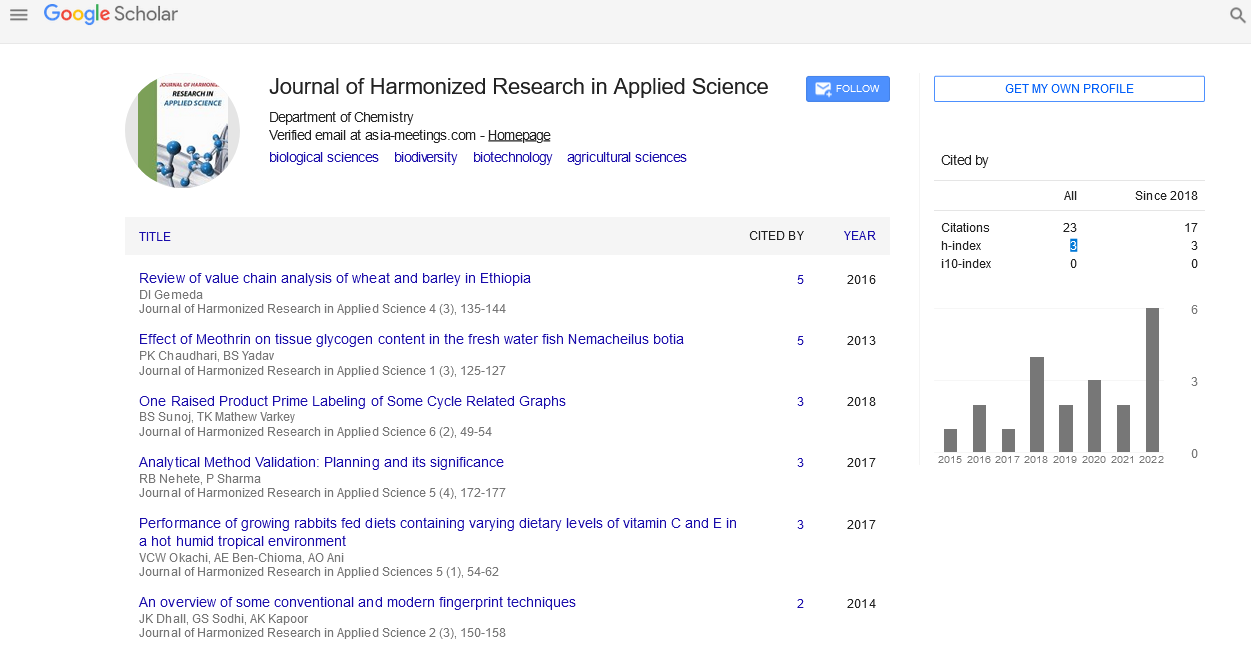Short Communication - (2022) Volume 10, Issue 2
IDENTIFICATION OF PATHOGENS BY NOVEL SEQUENCING METHODS
Haolin Sun*Received: May 27, 2022, Manuscript No. JHRAS-22-69279; Editor assigned: May 30, 2022, Pre QC No. JHRAS-22-69279(PQ); Reviewed: Jun 13, 2022, QC No. JHRAS-22-69279; Revised: Jun 20, 2022, Manuscript No. JHRAS-22-69279(R); Published: Jun 27, 2022, DOI: 10.30876/2321-7456.22.10.005.
Description
Sequencing the 16S rRNA gene (16S) is a reference method for bacterial identification. The increased use of it has increased the detection of new bacterial species. New species are rarely encountered in most laboratories, and it is often difficult to assess their potential pathogenicity. Partial 16S sequences from more than 26,000 clinical isolates analysed between February 2006 and June 2010 were reviewed and shared less than 99% sequence identity with valid reference sequences and thus latent. 673 were identified as a new species. Of these 673 isolates, 111 can represent a new genus .
Broad-range PCR amplification and sequencing of the 16S rRNA gene (16S sequencing) is not only widely used as a taxonomic tool but is recognized as an effective reference method for bacterial identification. It has been used to identify novel and emerging pathogens and to define complex microbial communities. The method has also revolutionized our understanding of microbial diversity. In clinical microbiology laboratories, 16S sequencing is useful for classifying microorganisms from pure culture. Molecular identification is especially valuable for bacteria that are slow growing, biochemically inert or variable, and fastidious, and it has also enhanced our understanding of previously unrecognized, often opportunistic pathogens [1].
Microorganisms have evolved to survive in all kinds of conditions on earth, including the human and animal bodies. Many are not harmful, but some can cause life-threatening illnesses. Traditionally, these are cultured in appropriate media and identified by biochemical or serological tests. However, more microorganisms need to be characterized than known. Recent advances in sequencing techniques and computational approaches have increased the likelihood of a complete understanding of microbial-environment interactions, successful with many types of microorganisms, and standardized with most known human and livestock pathogens.
Since the estimated number of microbial species is listed, it can be applied to a relatively small number of species. Many microorganisms are very difficult to culture or do not grow at all, and they cannot be identified by conventional techniques. It is estimated that up to 99% of all microbial species fall into this category [2]. This is especially problematic when unknown illnesses are widespread in human and animal populations. Metagenomics was recently introduced to study the genomic content of environmental samples of microorganisms. This is a derivative of traditional microbial genomics, but the main difference is that it is not necessary to obtain a pure culture for sequencing. Since the samples are from the community rather than the isolated population, metagenomics can be used to make hypotheses about interactions between members of the microbial community. Nucleic acid and protein databases have been created since the protein sequence database was first compiled in the 1960s. It has been driven primarily by evolving sequencing techniques and advanced computer programs for assembly, annotation, and retrieval. When the number of base pairs that could be sequenced in a single reaction reached billions of bases, it became necessary to develop software programs for compilation and comparison. The development of powerful alignment and annotation programs has helped identify inaccurate sequence assemblies and improve existing databases. For example, a retro-analysis of 202 published bacterial and viral metagenomics using the recently developed computational program revealed that 64% of metagenomics contain human DNA contamination [3,4].
Deep sequencing is a technique based on highly parallelized DNA sequence analysis that produces thousands to millions of sequence reads per run [5]. Instruments commonly used today to identify and analyze pathogens include the Roche 454 pyro sequencing system and the illumina genetic analyser. This method includes virus associated with hemorrhagic fever in South Africa, virus associated with the fatal disease of transplant recipients. Mutation breeding, sometimes referred to as “variation breeding”, is the process of exposing seeds to chemicals, radiation, or enzymes in order to generate mutants with desirable traits to be bred with other cultivars. Plants created using mutagenesis are sometimes called as mutagenic plants or mutagenic seeds. From 1930 to 2014 more than 3200 mutagenic plant varieties were produced, that have been derived either as direct mutants (70%) or from their progeny (30%). Crop plants account for 75% of released mutagenic species with the remaining 25% ornamentals or decorative plants. However, although the Food and Agriculture Organization reported in 2014 produced 1,000 mutant varieties of major staple crops were being grown worldwide, it is unclear that how many of these varieties are currently used in agriculture or horticulture around the world, as these seeds are not always identified or labelled as having a mutagenic provenance. Mutation breeding, in the case of self-pollinated crops that are disseminated by seed, is based on the self-fertilization or selfing of mutants until the induced desired character is stably expressed in advanced mutant generations. Often backcrossing to the original non mutated genotype (part of the DNA sequence of a cell that determines its specific characteristics) is necessary to retain its favourable characteristics.
References
- Korbie DJ, Mattick JS. Touchdown PCR for increased specificity and sensitivity in PCR amplification. Nat Protoc. 2008;3(9):1452-1456.
[Crossref] [Google Scholar] [PubMed]
- Kozomara A, Griffiths-Jones S. miRBase: Integrating microRNA annotation and deep-sequencing data. Nucleic Acids Res. 2010;39:152-157.
- Ramírez F, Dündar F, Diehl S, Grüning BA, Manke T. Deep tools: A flexible platform for exploring deep-sequencing data. Nucleic Acids Res. 2014;42:190-191.
[Crossref] [Google Scholar] [PubMed]
- McElroy K, Thomas T, Luciani F. Deep sequencing of evolving pathogen populations: Applications, errors, and bioinformatic solutions. Microb Inform Exp. 2014;4(1):1-4.
[Crossref] [Google Scholar] [PubMed]
- Doan T, Wilson MR, Crawford ED, Chow ED, Khan LM, Knopp KA, et al. Illuminating uveitis: Metagenomic deep sequencing identifies common and rare pathogens. Genome Med. 2016;8(1):1-9.










